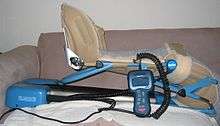Continuous passive motion

Continuous passive motion (CPM) devices are used during the first phase of rehabilitation following a soft tissue surgical procedure or trauma. The goals of phase 1 rehabilitation are: control post-operative pain, reduce inflammation, provide passive motion in a specific plane of movement, and protect the healing repair or tissue. CPM is carried out by a CPM device, which constantly moves the joint through a controlled range of motion; the exact range is dependent upon the joint, but in most cases the range of motion is increased over time.
CPM is used following various types of reconstructive joint surgery such as knee replacement and ACL reconstruction. Its mechanisms of action for aiding joint recovery are dependent upon what surgery is performed. One mechanism is the movement of synovial fluid to allow for better diffusion of nutrients into damaged cartilage, and diffusion of other materials out; such as blood and metabolic waste products. Another mechanism is the prevention of fibrous scar tissue formation in the joint, which tends to decrease the range of motion for a joint. The concept was created by Robert B. Salter M.D in 1970 and, along with help from engineer John Saringer, a device was created in 1978.[1][2]
CPM Following Knee Arthroplasty
For people who have had total knee replacement without complications, continuous passive motion has not been shown to provide clinically relevant benefits.[3] CPM does not improve long-term function, long-term knee flexion, knee extension in the short or long term, and has not been shown to reduce pain and or increase quality of life.[3] Additionally, CPM is expensive, inconvenient, and brings risk of complication while distracting patients from useful treatment.[3] In unusual cases where the person has problems which prevent standard mobilization treatment, then CPM may be useful.[3] Patient compliance is key to rehabilitation. Furthermore, with patients attempting at-home therapies, most follow orders with improper form that either limits improvement or in some cases, causes harm [4]
CPM Following Strokes
There are limited occupational therapies that are fully supported across a spectrum of patients. The fundamental movements provided by the CPM units, potentially allows for a remedial and fast progressing therapy.[5] This is according to the University of California. This is an untapped potential for these stroke victims that needs to be further explored, according to the same source. CPM units are a rare form of therapy that directly correlates the amount of use to the amount of progress. It is easy to neglect at-home therapeutic exercises for various reasons, but CPMs can be used while watching television or doing anything stationary. This ability to multi-task therapy with recreational activities hold higher promise for patients completing the therapy at home. Completing the therapy at home is just as important as prescribing it. That is why some studies suggest physical and occupational therapy yield better results than CPM units. CPM units should be used supplementary; also, these studies have fully compliant PT and OT patients whereas most patients do not fulfill their at-home exercises as often or with proper form that is suggested in these studies.[6][7]
References
- ↑ Salter RB (May 1989). "The biologic concept of continuous passive motion of synovial joints. The first 18 years of basic research and its clinical application". Clin. Orthop. Relat. Res. (242): 12–25. PMID 2650945.
- ↑ Salter RB, Hamilton HW, Wedge JH, et al. (1984). "Clinical application of basic research on continuous passive motion for disorders and injuries of synovial joints: a preliminary report of a feasibility study". J. Orthop. Res. 1 (3): 325–42. doi:10.1002/jor.1100010313. PMID 6481515.
- 1 2 3 4 American Physical Therapy Association (15 September 2014), "Five Things Physicians and Patients Should Question", Choosing Wisely: an initiative of the ABIM Foundation, American Physical Therapy Association, retrieved 15 September 2014, which cites
- Harvey, LA; Brosseau, L; Herbert, RD (Mar 17, 2010). "Continuous passive motion following total knee arthroplasty in people with arthritis.". Cochrane database of systematic reviews (Online) (3): CD004260. doi:10.1002/14651858.CD004260.pub2. PMID 20238330.
- ↑ Pollock ML, Carroll JF, Graves JE, Leggett SH, Braith RW, Limacher M, Hagberg JM (1991). "Injuries and adherence to walk/jog and resistance training programs in the elderly". Med Sci Sports Exerc. 23: 1194–200. doi:10.1249/00005768-199110000-00014. PMID 1758297.
- ↑ http://ptrehab.ucsf.edu/sites/ptrehab.ucsf.edu/files/documents/The%20Effects%20of%20Continuous%20Passive%20Motion%20Interventions%20on%20Function%20in%20Patients%20Following%20Hemiplegic%20Stroke%20-%20An%20Evidence-Based%20Review.pdf
- ↑ http://jech.bmj.com/content/55/2/132.short
- ↑ http://www.pec-journal.com/article/0738-3991(91)90060-I/abstract?cc=y
External links
- O'Driscoll SW, Giori NJ (2000). "Continuous passive motion (CPM): theory and principles of clinical application". J Rehabil Res Dev. 37 (2): 179–88. PMID 10850824.
- CPM — CONTINUOUS PASSIVE MOTION
- CPM — Robert B. Salter